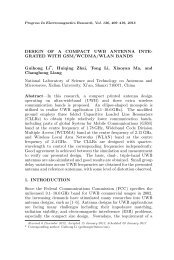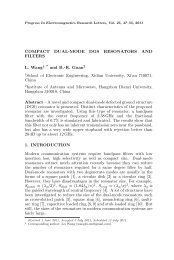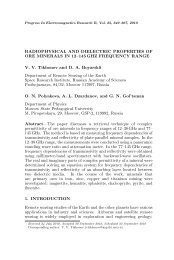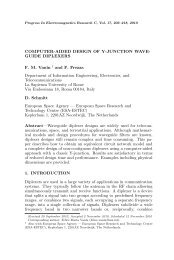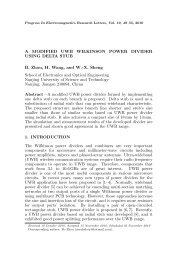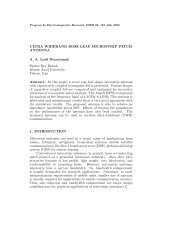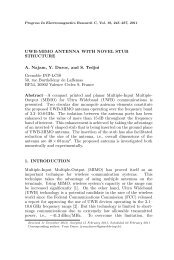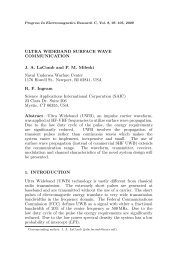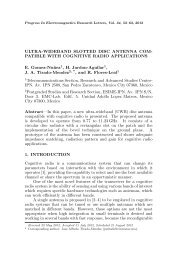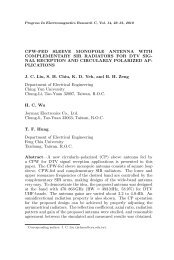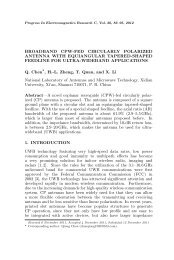PDF File (979 KB) - PIER
PDF File (979 KB) - PIER
PDF File (979 KB) - PIER
Create successful ePaper yourself
Turn your PDF publications into a flip-book with our unique Google optimized e-Paper software.
122 Angermann and Yatsyk<br />
We mention that the behaviour of both the quantities Im(ε nκ ) and<br />
Re(ε nκ (z, α(z), U(κ; z), U(2κ; z), U(3κ; z))<br />
−ε 3κ (z, α(z), U(κ; z), U(2κ; z), U(3κ; z)))<br />
= α(z) [ δ n1 |U(κ; z)||U(3κ; z)|<br />
×Re (exp {i [−3arg(U(κ; z)) + arg(U(3κ; z))]})<br />
+ δ n2 |U(κ; z)||U(3κ; z)| ×<br />
×Re (exp {i [−2arg(U(2κ; z))+arg(U(κ; z)) + arg(U(3κ;z))]}) ] ,<br />
n = 1, 2, (19)<br />
plays an essential role in the process of third harmonic generation.<br />
We mention that the impact of a strong electromagnetic field<br />
with an amplitude a inc<br />
κ even in the absence of a weak field a inc<br />
2κ = 0<br />
(where U(2κ; z) = 0) induces a nontrivial component of the nonlinear<br />
dielectric permittivity at the frequency 2κ. Figures 4(c), (d) show that<br />
the existence of nontrivial values Re(ε 2κ ) ≠ Re(ε (L) ) and Im(ε 2κ ) ≠ 0<br />
is caused by the amplitude and phase characteristics of the fields<br />
U(κ; z) and U(3κ; z). Moreover, the nonlinear component of the<br />
dielectric permittivity, which is responsible for the variation of Im(ε nκ )<br />
(and Re(ε nκ − ε 3κ )), does not depend on the absolute value of the<br />
amplitude of the field at the double frequency |U(2κ; z)|, see (19)<br />
and (18). Thus, even a weak field includes a mechanism for the<br />
redistribution of the energy of the incident wave packet which is<br />
consumed for the scattering process and the generation of waves, cf.<br />
the dynamics of the surfaces #0 with #2/3 in Figure 4.<br />
The scattering and generation properties of the nonlinear<br />
structure in the ranges a inc<br />
κ ∈ [1, 24], a inc<br />
2κ = 2 3 ainc κ and ϕ κ = 0 ◦ of<br />
the parameters of the incident field are presented in Figures 5&6(a).<br />
Figure 5 shows the same dependencies as Figure 6(a) but with the<br />
additional parameter a inc<br />
2κ . So it is possible to track the dynamics of<br />
the scattering, generation and energy characteristics of the nonlinear<br />
layer under the influence of an incident wave package consisting of a<br />
strong and a weak magnetic field with amplitudes a inc<br />
κ and a inc<br />
2κ , resp.<br />
The graphs in Figure 6 show the dynamics of the scattering<br />
(R κ [ϕ κ , a inc<br />
κ , a inc<br />
2κ ], T κ[ϕ κ , a inc<br />
κ , a inc<br />
2κ ], R 2κ[ϕ κ , a inc<br />
κ , a inc<br />
2κ ], T 2κ[ϕ κ , a inc<br />
κ ,<br />
a inc<br />
2κ ]) and generation (R [<br />
3κ ϕκ , a inc<br />
κ , a inc ] [<br />
2κ , T3κ ϕκ , a inc<br />
κ , a inc ]<br />
2κ ) properties<br />
of the structure.<br />
In the resonant range of wave scattering and generation<br />
frequencies, i.e., κ scat := κ inc = κ and κ gen = 3κ, resp., the dynamical<br />
behaviour of the characteristic quantities depicted in Figure 6 has the<br />
following causes. The scattering and generation frequencies are close to<br />
the corresponding eigen-frequencies of the linear (α = 0) and linearised<br />
nonlinear (α ≠ 0) spectral problems. Furthermore, the distance




